Blank L., Tarquin A. Engineering Economy (McGraw-Hill Series in Industrial Engineering and Management)
Подождите немного. Документ загружается.

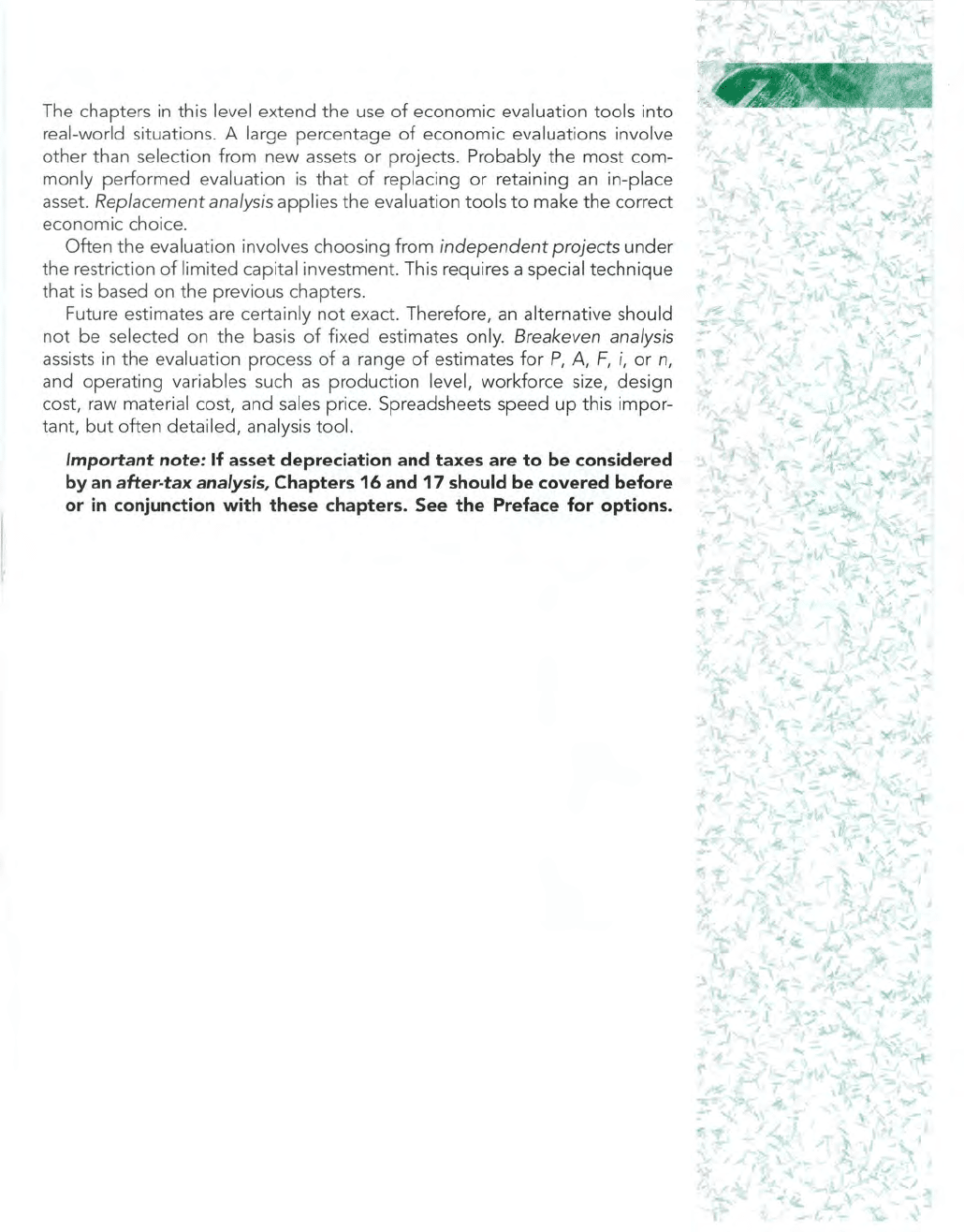
The ch
apte
rs in this level
ex
t
end
the u
se
of
e
co
nomic
ev
al
uation
tools
into
real-world situ
at
ions. A large
pe
r
centage
of
eco
n
omi
c evaluations involve
ot
h
er
than
se
l
ect
ion
fr
om
new assets
or
pro
je
cts.
Probably
the
most
c
om-
monly
performed
evaluati
on
is
t
hat
of
replac
ing
or
retaining an i
n-place
asset. R
eplacement
analysis
app
lies the evaluation
tools
to
make
the
correct
econom
ic choice.
Often
the
eva
lu
atio
n involves ch
oosing
fr
om
independent
projects
unde
r
the
restriction of l
imited
capital
investme
nt. Th
is
requires a special
technique
that
is
based on the pr
evio
us ch
apters
.
Future estimates are
certainly
not
exact. Therefore, an
alternative
should
n
ot
be
se
lected on
th
e basis
of
fixed es
timate
s
only
. Breakev
en
analysis
ass
ists in
th
e eva
lu
ati
on
process of a ran
ge
of
est
imates
for
P,
A,
F,
i,
or
n,
an
d operating
va
ri
ab
les such
as
pro
duction level,
workfor
ce size,
design
cost, raw mate
ri
al cost, a
nd
sales p
ri
ce. Spreadsheets
speed
up
this
impor-
ta
nt
,
but
o
ft
en detailed, analysis tool.
Important
note:
If
asset
depreciation
and
taxes
are
to
be
considered
by
an
after-tax
analysis,
Chapters
16
and
17
should
be
covered
before
or
in
conjunction
with
these
chapters. See
the
Preface
for
options.

11
UJ
I
u
Replacement and
Retention Decisions
One
of
the
most
commonly
performed
engineering
economy
studies
is
that
of
replacement
or
retention
of
an asset
or
system
that
is
currently installed.
This differs
from
previous studies
where
all
the
alternatives are
new
. The
fundamental
question
answered
by
a
replacement
study
about
a currently
installed asset
or
system
is,
Should
it
be
replaced
now
or
later?
When
an
asset
is
currently
in
use
and
its
function
is
needed
in
the
future,
it
will
be
replaced
at
some
time
. So, in reality, a
replacement
study
answers
the
ques-
tion
of
when,
not
if,
to
replace.
A
replacement
study
is
usually
designed
to
first
make
the
economic
deci-
sion
to
retain
or
replace
now
.
If
the
decision
is
to
replace,
the
study
is
com-
plete.
If
the
decision
is
to
retain,
the
cost
estimates
and
decision
will
be
revisited each year
to
ensure
that
the
decision
to
retain
is
still
economically
correct. This
chapter
explains
how
to
perform
the
initial year
and
follow-on
year
replacement
studies.
A
replacement
study
is
an
application
of
the
AW
method
of
comparing
unequal-life
alternatives, first
introduced
in
Chapter
6.
In
a
replacement
study
with
no
specified
study
period,
the
AW
values are
determined
by
a
technique
of
cost
evaluation
called
the
economic
service life
(ESL)
analysis.
If a
study
period
is
specified,
the
replacement
study
procedure
is
different
from
that
used
when
no
study
period
is
set
. All
these
procedures
are
covered
in
this
chapter.
The
case
study
is
a real-world
replacement
analysis
involving
in-place
equipment
and possible
replacement
by
upgraded
equipment.
If
asset depreciation and taxes are
to
be
considered
in
an
after-tax
replacement
analysis, Chapters
16
and
17
should be covered before
or
in
conjunction
with
this chapter.
After-tax
replacement analysis
is
included
in
Section
17.7.
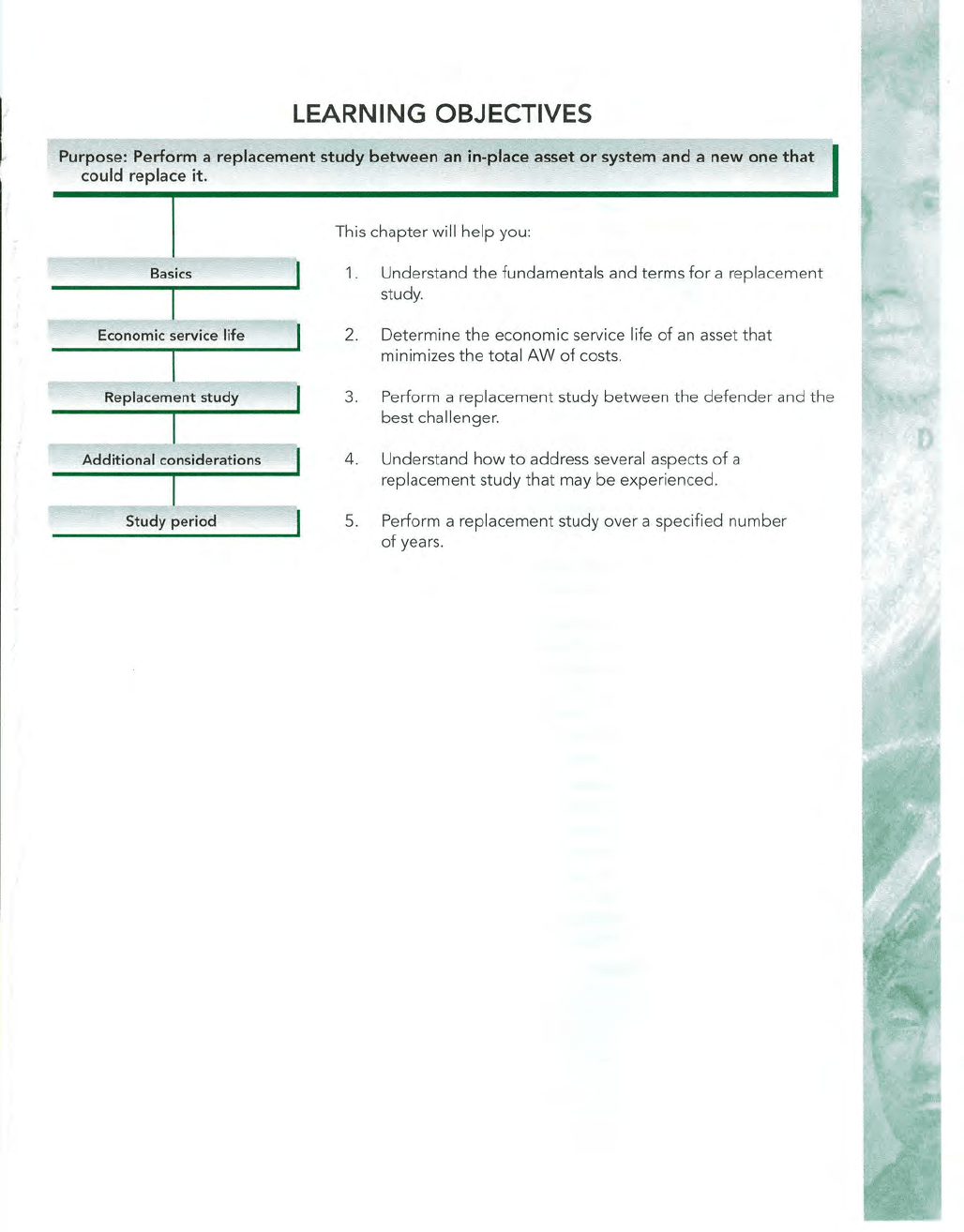
LEARNING OBJECTIVES
Purpose: Perform a replacement study
between
an
in-place asset
or
system and a
new
one
that
could replace it.
Basics
Economic service life
Replacement
study
Study period
This
chapter
will
help
you:
1.
Understand
the
fundamentals
and
terms
for
a
replacement
study
.
2.
Determine
the
econom
ic service
lif
e
of
an
asset
that
minimizes
the
total
AW
of
costs.
3. Perform a
replacement
study
between
the
defender
and
the
best
challenger.
4.
Understand
how
to
address several aspects
of
a
replacement
study
that
may
be
experienced.
5. Perform a
replacement
study
over
a
specified
number
of
years.
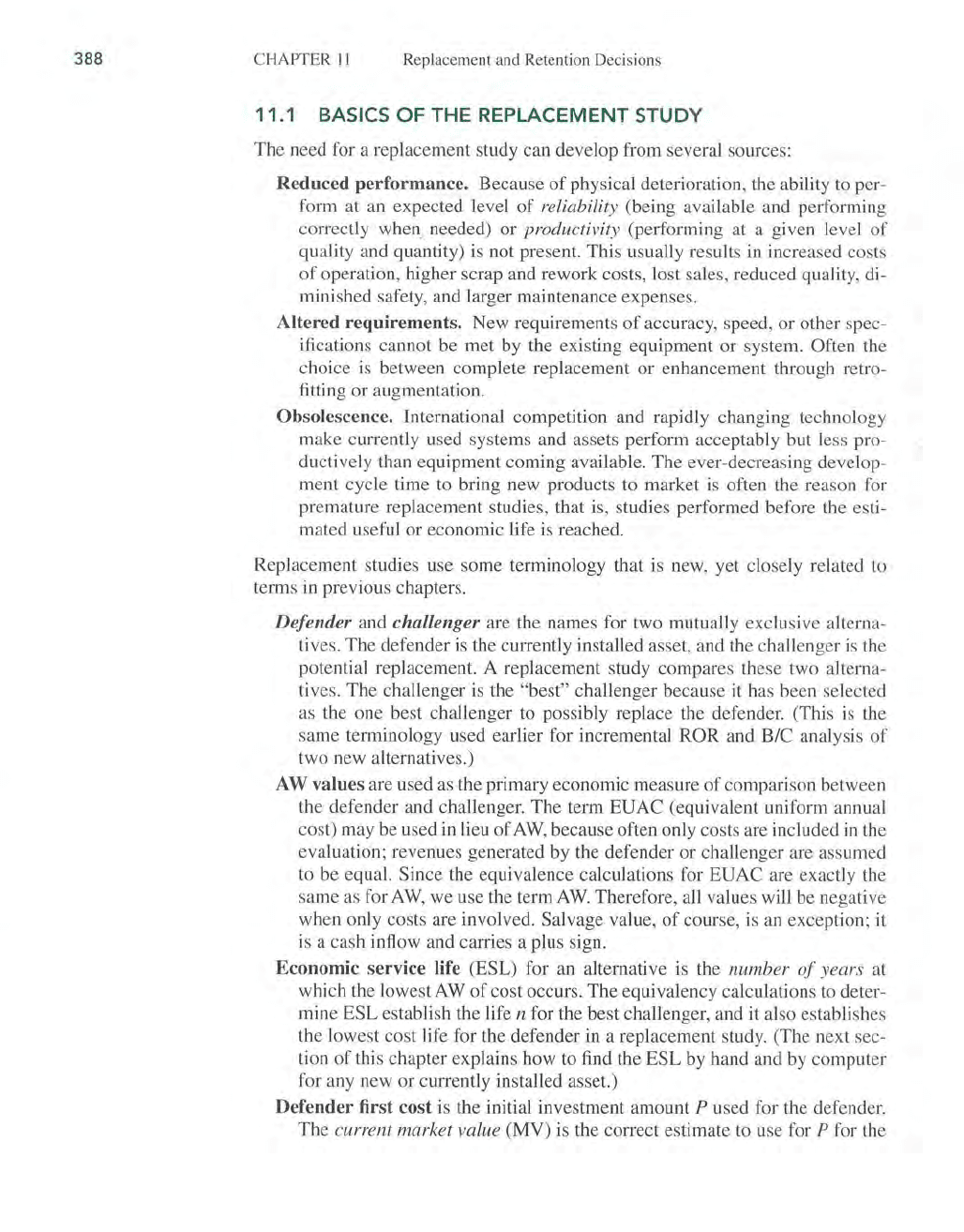
388 CHAPTER
II
Replacement and Retention Decisions
11.1 BASICS OF THE REPLACEMENT STUDY
The need for a replacement study can develop from several sources:
Reduced
performance.
Because
of
physical deterioration, the ability to per-
form at an expected level
of
reliability (being available and performing
correctly
when, needed) or productivity (performing at a given level
of
quality and quantity) is not present. This usually results in increased costs
of
operation, higher scrap and rework costs, lost sales, reduced quality, di-
minished safety, and larger maintenance expenses.
Altered
requirements.
New requirements
of
accuracy, speed, or other spec-
ifications cannot be met by the existing equipment or system.
Often the
choice is between complete replacement or enhancement through retro-
fitting or augmentation.
Obsolescence. International competition and rapidly changing technology
make currently used systems and assets perform acceptably but less pro-
ductively than equipment coming available. The ever-decreasing develop-
ment cycle time to bring new products to market is often the reason for
premature replacement studies, that is, studies performed before the esti-
mated useful or economic life is reached.
Replacement studies use some terminology that is new, yet closely related
to
terms
in
previous chapters.
Defender
and
challenger
are the names for two mutually exclusive alterna-
tives. The defender is the currently installed asset, and the challenger is the
potential replacement. A replacement study compares these two alterna-
tives. The challenger
is
the "best" challenger because it has been selected
as the one best challenger to possibly replace the defender. (This
is
the
same terminology used earlier for incremental
ROR
and B/C analysis of
two new alternatives.)
A W values are used as the primary economic measure
of
comparison between
the defender and challenger. The term
EUAC (equivalent uniform annual
cost) may be used in lieu
of
AW,
because often only costs are included
in
the
evaluation; revenues generated by the defender
or
challenger are assumed
to be equal. Since the equivalence calculations for
EUAC are exactly the
same as for A
W,
we use the term A W. Therefore, all values will be negati ve
when only costs are involved. Salvage value,
of
course,
is
an exception; it
is
a cash inflow and carries a plus sign.
Economic
service life (ESL) for an alternative is the
number
of
years at
which the lowest
AW
of
cost occurs. The equivalency calculations to deter-
mine
ESL
establish the life n for the best challenger, and it also establishes
the lowest cost life for the defender in a replacement study. (The next sec-
tion
of
this chapter explains how to find the
ESL
by hand and by computer
for any new or currently installed asset.)
Defender
first cost is the initial investment amount P used for the defender.
The
current
market
value (MV) is the correct estimate to use for P for the
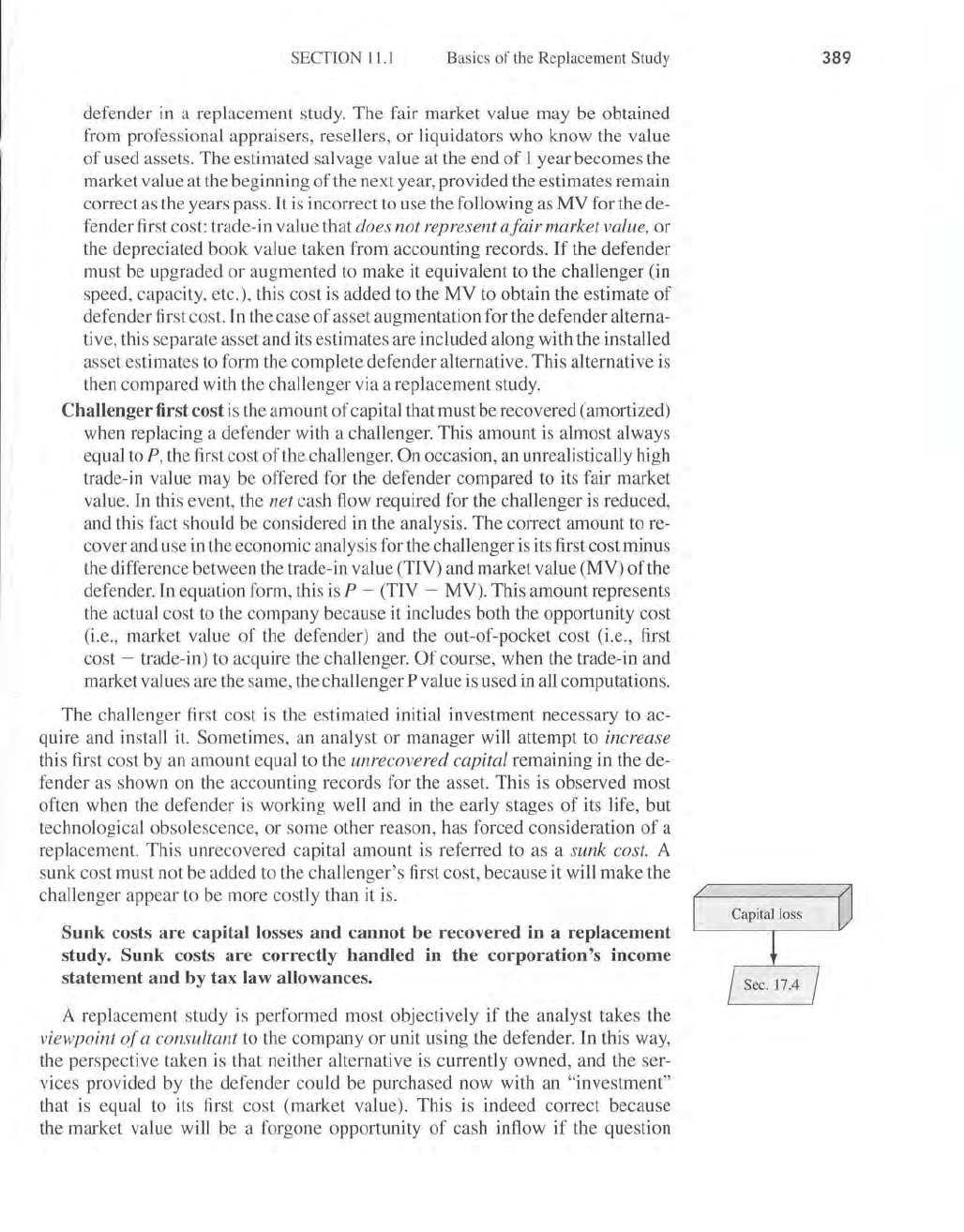
SECTION
11.1
Basics
of
the Replacement Study
defender
in
a replacement study. The fair market value may be obtained
from professional appraisers, resellers, or liquidators who know the value
of
used assets.
The
estimated salvage value at the end
of
1 year becomes the
market value at the beginning
ofthe
next year, provided the estimates remain
correct
as
the years pass. It
is
incorrect to use the following as
MV
for the de-
fender first cost: trade-i n val ue that
does not represent
afair
market value, or
the depreciated book value taken from accounting records.
If
the defender
must be upgraded or augmented to make it equivalent to the challenger (in
speed, capacity, etc.), this cost is added to the
MV
to obtain the estimate
of
defender first cost. In the case
of
asset augmentation for the defender alterna-
tive, this separate asset and its estimates are included along with the installed
asset estimates to form the complete defender alternative. This alternative is
then compared with the challenger via a replacement study.
Challenger first cost
is
the amount
of
capital that must be recovered (amortized)
when replacing a defender with a challenger. This amount is almost always
equal to
P, the first cost
of
the challenger. On occasion, an unrealistically high
trade-
in
value may be offered for the defender compared to its fair market
value. In this event, the
net cash flow required for the challenger
is
reduced,
and this fact should be considered in the analysis. The correct amount to re-
cover and use in the economic analysis for the challenger
is
its first cost minus
the difference between the trade-in value (TIV) and market value (MV)
of
the
defender. In equation form, this
is
P - (TIV - MV). This amount represents
the actual cost to the company because it includes both the opportunity cost
(i.e., market value
of
the defender) and the out-of-pocket cost (i.e
.,
first
cost - trade-in) to acquire the challenger.
Of
course, when the trade-in and
market values are the same, the challenger
P value is used in all computations.
The
challenger first cost
is
the estimated initial investment necessary to ac-
quire and install
it.
Sometimes, an analyst or manager will attempt to increase
this first cost
by
an
amount equal to the unrecovered capital remaining in the de-
fender
as
shown on the accounting records for the asset. This is observed most
often when the defender
is
working well and in the early stages
of
its life, but
technological obsolescence, or some other reason, has forced consideration
of
a
replacement. This unrecovered capital amount is referred to as a
sunk cost. A
sunk cost must not be added to the challenger's first cost, because it will make the
challenger appear to be more costly than it is.
Sunk
costs
are
capital losses
and
cannot
be recovered in a replacement
study.
Sunk
costs
are
correctly handled in the
corporation's
income
statement
and
by tax law allowances.
A replacement study is performed most objectively
if
the analyst takes the
viewpoint
of
a consultant to the company or unit using the defender. In this way,
the perspective taken
is
that neither alternative is currently owned, and the ser-
vices provided
by
the defender could be purchased now with an "investment"
that is equal to its first cost (market value). This is indeed correct because
the market value will be a forgone opportunity
of
cash inflow if the question
389
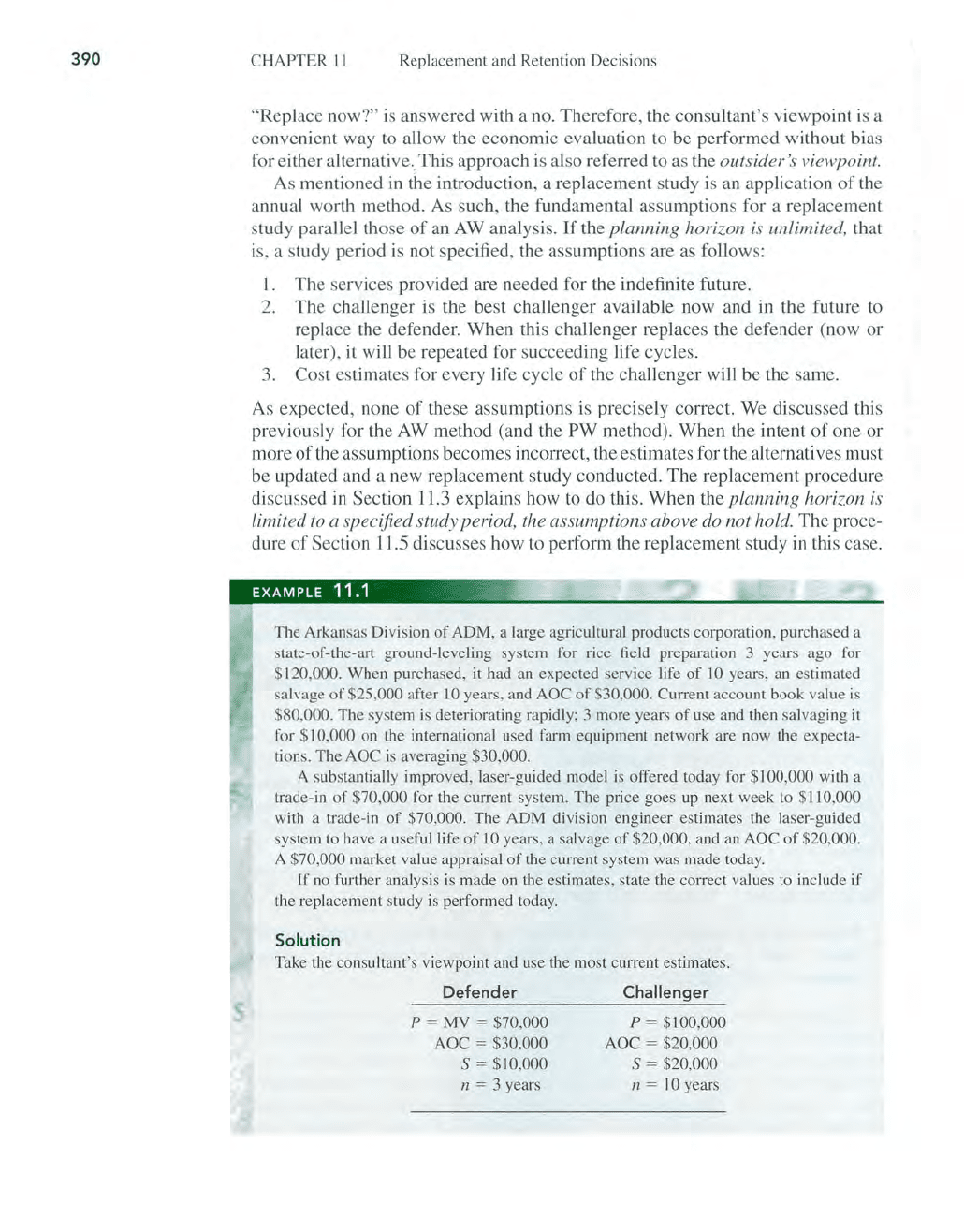
390
CHAPTER
II
Replacement and Retention Decisions
"Replace
now?" is answered with a no. Therefore, the consultant's viewpoint is a
convenient way to allow the economic evaluation to be performed without bias
for either alternative .. This approach is also referred to as the outsider's viewpoint.
As mentioned in the introduction, a replacement study is an application
of
the
annual worth method. As such, the fundamental assumptions for a replacement
study parallel those
of
an AW analysis.
If
the planning horizon is unlimited, that
is, a study period is not specified, the assumptions are as follows:
1.
The
services provided are needed for the indefinite future.
2.
The
challenger is the best challenger available now and in the future to
replace the defender. When this challenger replaces the defender (now
or
later), it will be repeated for succeeding life cycles.
3. Cost estimates for every life cycle
of
the challenger will be the same.
As expected, none
of
these assumptions
is
precisely correct. We discussed this
previously for the AW method (and the
PW
method).
When
the intent
of
one
or
more
of
the assumptions becomes incorrect, the estimates for the alternatives must
be updated and a new replacement study conducted.
The
replacement procedure
discussed
in
Section 11.3 explains how to do this.
When
the planning horizon
is
limited to a specified study period, the assumptions above do not hold.
The
proce-
dure
of
Section
11.S
discusses how to perform the replacement study
in
this case.
EXAMPLE 11.1
The Arkansas Division
of
ADM, a large agricultural products corporation, purchased a
state-of-the-art ground-leveling system for rice field preparation 3 years ago for
$120,000. When purchased, it had
an
expected service
Hie
of
10
years,
an
estimated
salvage
of
$25,000 after
10
years, and AOC
of
$30,000. Current account book value
is
$80,000. The system
is
deteriorating rapidly; 3 more years
of
use and then salvaging
it
for $10,000 on the intemational used farm equipment network are now the expecta-
tions. The
AOC
is
averaging $30,000.
A substantially improved, laser-guided model is offered today for $100,000 with a
trade-in
of
$70,000 for the current system. The price goes
up
next week to $110,000
with a trade-in
of
$70,000. The ADM division engineer estimates the laser-guided
system
to
have a useful life
of
10
years, a salvage
of
$20,000, and
an
AOC
of
$20,000.
A $70,000 market value appraisal
of
the current system was made today.
If no further analysis
is
made
on
the estimates, state the correct values to include if
the replacement
study
is
performed today.
Solution
Take the consultant's viewpoint and use the most current estimates.
Defender
P = MY = $70,000
AOC
= $30,000
S
= $10,000
n = 3 years
Challeng
er
P = $100,000
AOC
= $20,000
S
= $20,000
n = 10 years
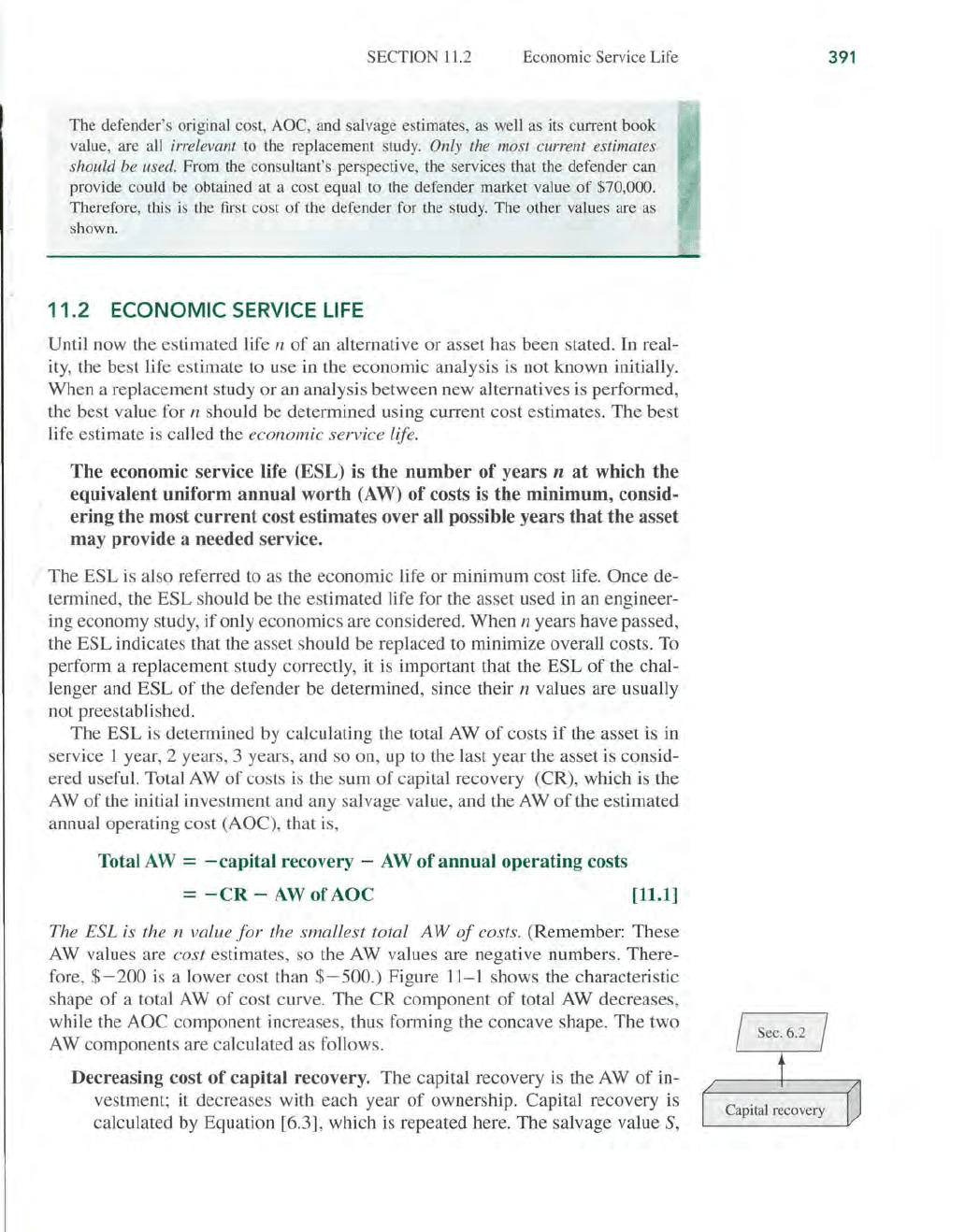
SECTION 11.2 Economic Service Life
The defender's original cost,
AOC, and salvage estimates, as well as its cnrrent book
value, are
all
irrelevant to the replacement study. Only the most current estimates
should be used. From the consultant's perspective, the services that the defender can
provide could be obtained at a cost equal to the defender market value of
$70,000.
Therefore, this
is
the first cost
of
the defender for the study. The other values are
as
shown.
11.2
ECONOMIC SERVICE
LIFE
Until now the estimated life n
of
an
alternative or asset has been stated.
In
real-
ity, the best life estimate to use
in
the economic analysis
is
not known initially.
When a replacement study or
an
analysis between new alternatives is performed,
the best value for n should be determined using current cost estimates. The best
life estimate
is
called the economic service life.
The
economic service life (ESL) is
the
number
of
years
n
at
which the
equivalent
uniform
annual
worth
(AW)
of
costs is
the
minimum,
consid-
ering
the
most
current
cost estimates
over
all possible
years
that
the asset
may provide a needed service.
The ESL
is
also referred
to
as
the economic life or minimum cost life. Once de-
termined, the ESL should be the estimated life for the asset used in
an
engineer-
ing economy study, if only economics are considered. When n years have passed,
the ESL indicates that the asset should be replaced to minimize overall costs. To
perform a replacement study correctly, it is important that the ESL
of
the chal-
lenger and ESL
of
the defender be determined, since their n values are usually
not preestablished.
The ESL
is
determined
by
calculating the total A W
of
costs
if
the asset is in
service 1 year, 2 years, 3 years, and so on, up
to
the last year the asset is consid-
ered useful. Total A W
of
costs is the sum
of
capital recovery (CR), which
is
the
AW
of
the initial investment and any salvage value, and the
AW
of
the estimated
annual operating cost
(AOC), that is,
Total AW =
-capital
recovery - AW
of
annual
operating
costs
=
-CR
-
AWofAOC
[11.1]
The
ESL
is
the n value
for
the smallest total A W
of
costs. (Remember: These
AW
values are cost estimates, so the
AW
values are negative numbers. There-
fore,
$-200
is
a lower cost than
$-500.)
Figure 11-1 shows the characteristic
shape
of
a total
AW
of
cost curve. The CR component
of
total
AW
decreases,
while the
AOC component increases, thus forming the concave shape. The two
A W components are calculated as follows.
Decreasing cost
of
capital recovery. The capital recovery
is
the A W
of
in-
vestment; it decreases with each year
of
ownership. Capital recovery
is
calculated
by
Equation [6.3], which
is
repeated here. The salvage value
S,
391
Capital
recovery
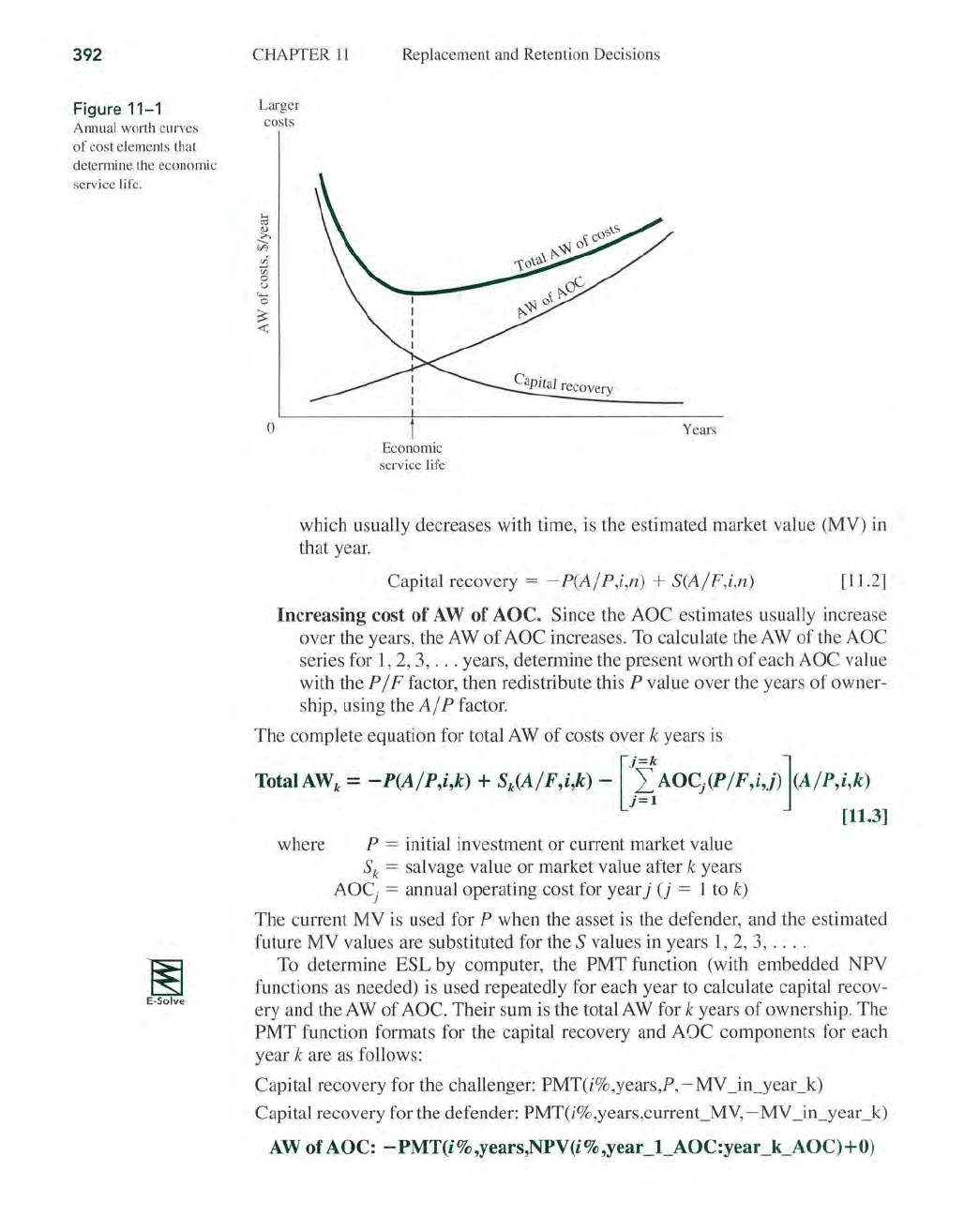
392
Figure
11
-1
Annual worth curves
of
cost elements that
determine the economic
se
rvi
ce life.
m
E-Solve
CHAPTER
11
Larger
co
sts
Replacement and Retention Decisions
Economic
service
lif
e
Years
which usually decreases with time, is the estimated market value (MV) in
that year.
Capital recovery
= -
p(AI
P,i,n) +
S(AI
F,i,n)
[11.2]
Increasing cost
of
AW
of
AOC. Since the
AOC
estimates usually increase
over the years, the AW
of
AOC increases. To calculate the AW
of
the AOC
series for 1,
2,
3,
..
. years, determine the present worth
of
each AOC value
with the
PI
F factor, then redistribute this P value over the years
of
owner-
ship, using the
AlP
factor.
The complete equation for total A W
of
costs over k years is
TotalAW
k
=
-P(A
IP,i,k) +
SiA
IF,i,k) -
[:~AOC/P
I
F'i,j)}A
I
P'i'k)
[11.3]
where
P = initial investment or current market value
Sk
= salvage value or market value after k years
AOC) = annual operating cost for year j
(j
= 1 to
k)
The current MV
is
used for P when the asset is the defender, and the estimated
future MV values are substituted for the S values in years
1,2
, 3, .
..
.
To determine
ESL
by computer, the
PMT
function (with embedded NPV
functions
as
needed)
is
used repeatedly for each year to calculate capital recov-
ery and the
AW
of
AOe.
Their sum is the total AW for k years
of
ownership. The
PMT
function formats for the capital recovery and AOC components for each
year
k are as follows:
Capital recovery for the challenger:
PMT(i%,years,P, - MY
_in_yeack)
Capital recovery for the defender: PMT(i%,years,currencMV, -
MV
_in_yeack)
AW
of AOC:
-PMT(i%,years,NPV(i%,yeacCAOC:year
_k_AOC)+O)

SECTION 11.2
Economic Service Life
When the spreadsheet is developed, it
is
recommended that the
PMT
functions
in
year I be developed using cell-reference format, then drag down the function
through each column. A final column summing the two
PMT
results displays
total A W. Augmenting the table with an Excel
xy
scatter plot graphically displays
the cost curves
in
the general form
of
Figure 11-1, and the
ESL
is easily identi-
fied. Example
11
.2 illustrates
ESL
determination by hand and by computer.
EXAM
PLE
11.2
:.~
A 3-year-o
ld
manufacturing process asset
is
being considered for early replacement. Its
cu
rrent market va
lu
e
is
$13,000. Estimated future market values and annual operating costs
for
the next 5 years are given
in
Table
II
-
I,
columns 2 and 3. What is the economic service
life
of
th
is defender if the interest rate is
10
% per year? Solve by hand and
by
computer.
TABLE
11-1
Computation
of
Economic Service Life
Capital
AWof
Total
Yearj
MVj
AOC
j
Recovery AOC
AW
k
(1
)
(2)
(3)
(4) (5)
(6)
= (4) + (5)
1
$9000
$
-2
500
$-5300 $-2500
$- 7800
2
8000
-2
700
-3
681
-2595
- 6276
3
6000
-3
000
-3
415
-2717
- 6132
4
2000
-3
500
-3
670
-2886
- 6556
5
0
- 4500
-3
429
-3150
- 6579
Solution by Hand
Equation [11.3 J is used to calculate total A W k for k = 1, 2,
...
, 5. Table 11-1, column 4,
shows the capi
tal
recovery for the $13,000 cun'ent market value
(j
=
0)
plus
10
% return.
Column 5 gives the equivalent
AW
of
AOC for k years. As an illustration, the comp
ut
ation
of
total
AW
for k = 3 from Equation [11.3J
is
Total
AW
3
= - P(A/P,i,3) +
MV
3
(A/
F,i,3) - [PW
of
AOC"AOC
2
,
and
AOC
3
J(A
/ P,i,3)
= -
13
,000(A/ P,
10
%,3) + 6000(A/ F,
1O
%,3) - [2500(P/ F,
1O
%,
1)
+ 2700(P/ F,
10
%,2) + 3000(P/F,JO%,3)](A/P,lO%,3)
=
-3415
- 2717 =
$-6132
A similar computat
ion
is
performed
fo
r each year I through
5.
The lowest equivalent cost
(numerically largest
AW
value) occurs at k = 3. Therefore, the defender ESL
is
n = 3 years,
and the
AW
value
is
$- 6132.
In
the replacement study, this
AW
will
be
compared with the
best challenger
AW
determined by a similar ESL analysis.
Solution by
Computer
See Figure
11
-2
for the spreadsheet and chart for this example. (This format
is
a template
for any ESL analysis; simply change the estimates and add rows for more years
.)
Contents
of
columns D and E are briefly described below. The PMT functions app
ly
the formats for
the defender
as
desclibed above. Cell tags show detailed cell-reference format for year
5.
The $
sy
mbols are
in
cluded for absolute cell referencing, needed when the entry is dragged
down through
th
e column.
393
m
E·Solve
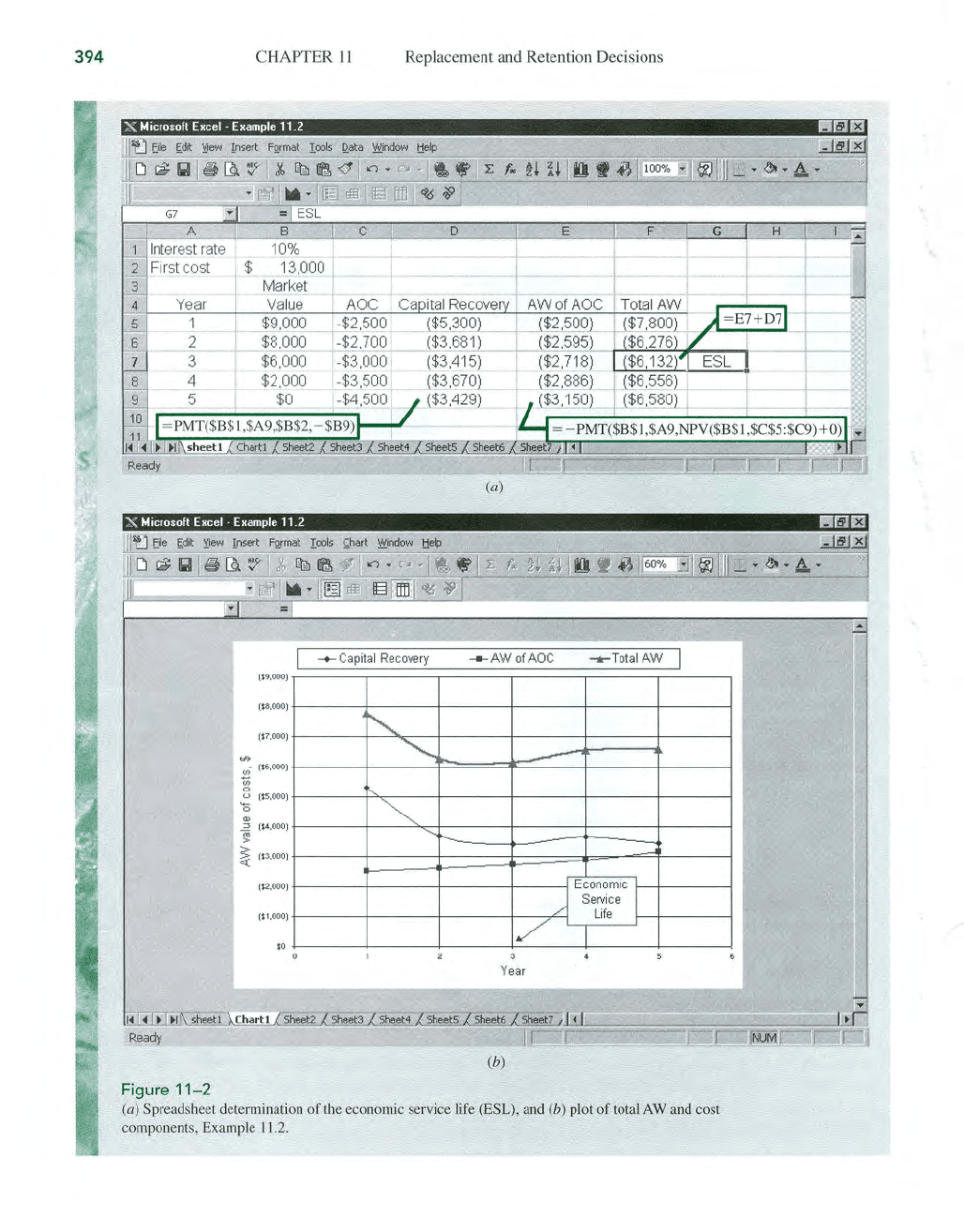
394
Ready
Figure
11-2
CHAPTER
II
Replacement and Retention Decisions
-+-
C
apital
Re
covery
($9,
000
)
($
S
.ooO)
($
7,
000)
""
"
~
~-
($
6,
000
)
U
($
5,000)
'0
'"
..=e
($4.000)
'"
>
~
'-..,
r--~
~
($
3
,0
00)
($
2
.0
00)
($1.00
0)
10
(a)
__
AWofAOC
/
3
Year
(b)
~
__
TotalAW I
--'
Economic
SelYice
I
Life
(a) Spreadsheet determination
of
the economic service life (ESL), and (b) plot
of
total
AW
and cost
components,
Example 11.2.
